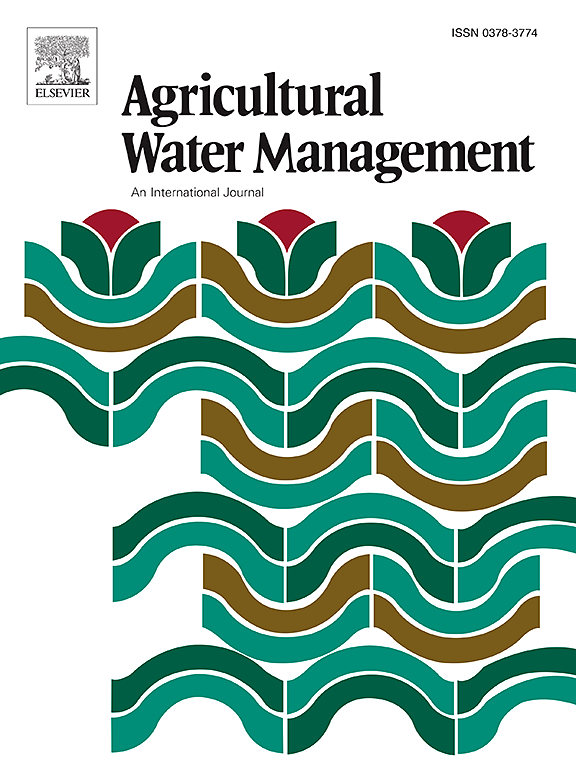利用宇宙射线中子感应和时域反射网络联合测量冻结绿洲土壤中尺度未冻水含量
IF 6.5
1区 农林科学
Q1 AGRONOMY
引用次数: 0
摘要
冻土水分是评估土壤热状态、水分状态和冻融动态的关键指标,对理解绿洲生态系统土壤水文过程至关重要。然而,在冻融循环过程中精确测量中尺度未冻水和冻结水含量仍然具有挑战性。本研究结合宇宙射线中子遥感(CRNS)和时域反射(TDR)网络,研究了绿洲生态系统在冻结期的中尺度冰-水转换特征,包括浅层地下水农田(FSG)、旧农田(OF)、新农田(NF)和人工林(AF)。结果表明,CRNS在荒漠-绿洲生态区内有效测量中尺度土壤水分,精度较高(R²= 0.930,RMSE = 0.027 cm3/cm3)。在中尺度上,CRNS和TDR网络有效地区分了冻结期的冻结水含量和冻结期的冻结水总量。未冻水含量范围为0.04至0.48 cm³ /cm³ ,与深层相比,表层的变化更大。冻结发生在OF、NF和AF中,从上到下,而FSG呈现双向冻结模式。冷冻率最高的是FSG,其次是NF、AF和OF。在整个冻结期,OF保持了较高比例的未冻水含量,而AF保持了最低比例。土壤温度是主要影响因子。在0℃以下,未冻水含量与温度呈指数关系,而在0℃以上,则呈幂函数关系。这些发现增强了我们对冻融过程的认识,并为绿洲生态系统中尺度冻土水分监测提供了有价值的见解。本文章由计算机程序翻译,如有差异,请以英文原文为准。
Mesoscale unfrozen water content measurements in frozen oasis soils using combined cosmic-ray neutron sensing and time domain reflectometry networks
Frozen soil water is a key indicator for assessing soil thermal regimes, moisture status, and freeze-thaw dynamics, which are crucial for understanding soil hydrological processes in oasis ecosystems. However, accurately measuring mesoscale unfrozen and frozen water contents during freeze-thaw cycles remains challenging. This study combines Cosmic-Ray Neutron Sensing (CRNS) and Time Domain Reflectometry (TDR) networks to investigate ice-water transformation characteristics at the mesoscale in oasis ecosystems, including farmland with shallow groundwater (FSG), old farmland (OF), new farmland (NF), and artificial forest (AF) during the freezing period. The results show that CRNS effectively measured mesoscale soil moisture with high accuracy in desert-oasis ecoregion (R² = 0.930, RMSE = 0.027 cm3/cm3). While, the parameter N0 for farmland sites was similar, though it was lower for AF. The integrated CRNS and TDR networks effectively differentiated the frozen water content from the total value during the freezing period at the mesoscale. Unfrozen water content ranged from 0.04 to 0.48 cm³ /cm³ , with more variation in surface layers compared to deeper layers. Freezing occurred from the top to down in OF, NF, and AF, whereas FSG exhibited a bidirectional freezing pattern. Freezing rates were highest in FSG, followed by NF, AF, and OF. The OF retained a higher proportion of unfrozen water content, while AF maintained the lowest ratio throughout the freezing period. Soil temperature was the dominant factor. Below 0°C, unfrozen water content exhibited an exponential relationship with temperature, while above 0°C, it followed a power relationship. These findings enhance our understanding of freeze-thaw processes and provide valuable insights for monitoring mesoscale unfrozen soil moisture in oasis ecosystems.
求助全文
通过发布文献求助,成功后即可免费获取论文全文。
去求助
来源期刊

Agricultural Water Management
农林科学-农艺学
CiteScore
12.10
自引率
14.90%
发文量
648
审稿时长
4.9 months
期刊介绍:
Agricultural Water Management publishes papers of international significance relating to the science, economics, and policy of agricultural water management. In all cases, manuscripts must address implications and provide insight regarding agricultural water management.
 求助内容:
求助内容: 应助结果提醒方式:
应助结果提醒方式:


